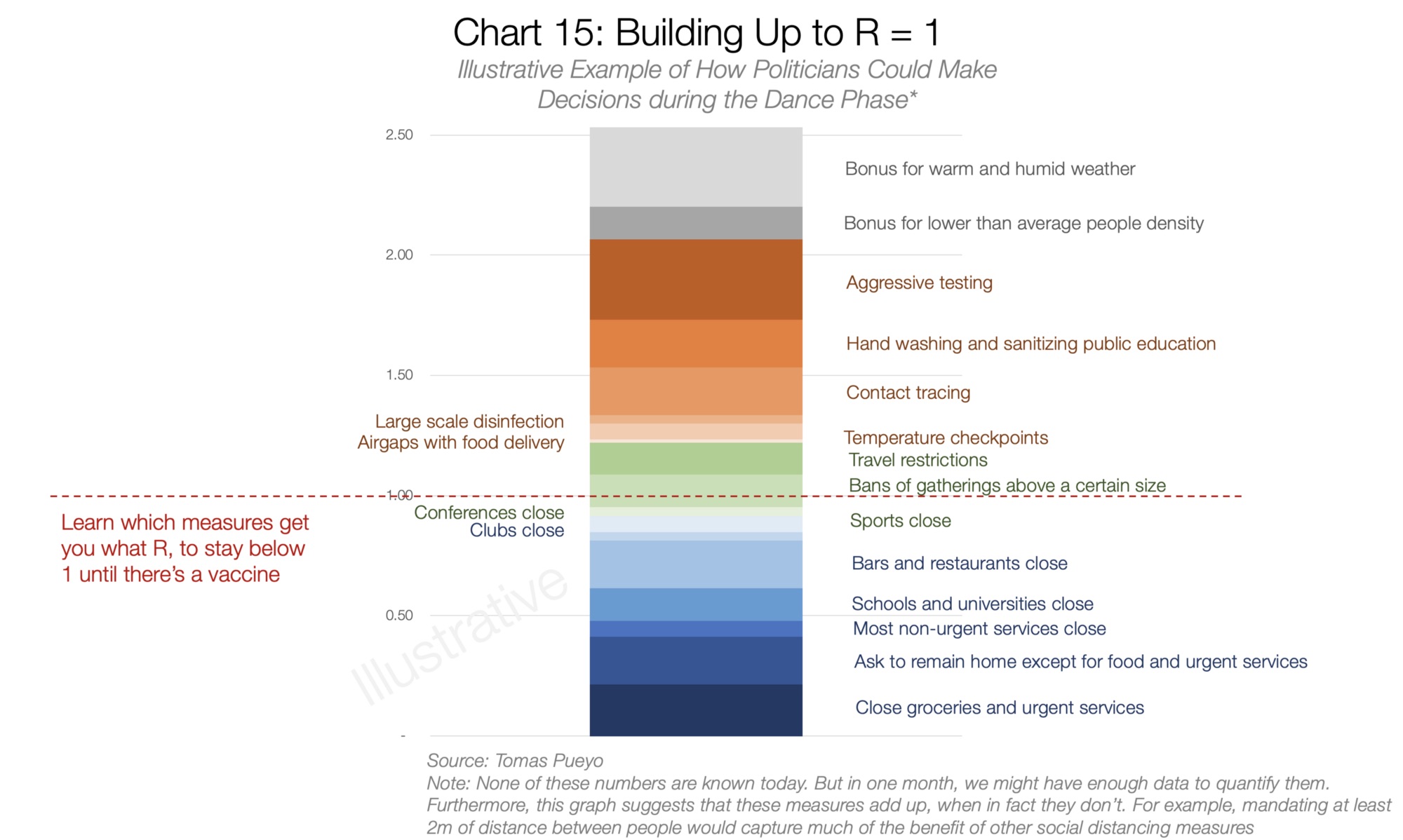The Coronavirus Endgame 5: Let the dance begin

Tomas Pueyo, Coronavirus: The hammer and the dance on Medium https://medium.com/@tomaspueyo/coronavirus-the-hammer-and-the-dance-be9337092b56
Part 5 of 5 in a series on how the pandemic ends, and how we get there. Please share. Link to part 1, part 2, part 3, part 4.
Coronavirus Endgame Part 5: Let the Dance Begin
Like part 4, this final article in my Endgame series is part science, part editorial / opinion piece.
The scope of topics related to loosening social distancing is broad, and it took a while for me to condense my thoughts. In the end, I borrowed an idea from a writer named Tomas Pueyo to structure this post. In an article he published back on March 19 on Medium, Pueyo coined the phrase “hammer and dance” to describe the approach to pandemic mitigation.
The Hammer
Pueyo’s “hammer” is the suppression strategy we’ve been experiencing as lockdowns in recent weeks. As I described in my Endgame post #2, this intense social distancing postpones but does not prevent coronavirus deaths unless something else happens.
Something else has happened.
Actually many things have happened since mid-March. In the US, hospital surge capacity has been built. Better techniques for treating COVID-19 patients are being learned. Production of personal protective equipment or PPE (masks, etc.) has ramped up. Testing has been expanded. Maybe most important of all, most Americans have gotten the message that their behavior matters. We now avoid touching each other and touching objects. We expect people to keep their distance. We’re washing and disinfecting. We’re wearing masks. These non-pharmaceutical interventions, or NPIs, will reduce the spread of SARS-CoV-2 even as we re-open various activities.
At some point the “hammer” phase accomplishes its goal to arrest the epidemic. Then it’s time to dance. Pueyo defines the “dance” as the time between getting the pandemic under control, and a vaccine. It’s a long-term effort to keep the virus contained, to keep the curve flat. The “dance” is a period of loosening social distancing and other restrictions Goldilocks-style: just enough to make us more comfortable without triggering a disease spike.
The “dance” will be our new normal for at least the rest of 2020, and possibly much of 2021.
If our quest for a vaccine fails, “dance” will be our normal until we reach natural herd immunity (~70% of the population has been infected with SARS-CoV-2).
ASIDE: Is the dance worth it?
At this point it’s clear that to drop all NPIs and let the virus run free until everybody either recovers or dies (natural herd immunity for the whole population) is a terrible idea. Although there is much we still don’t know about the mortality rate of the coronavirus in various situations, we have learned over the past few months that it’s deadly enough to make “doing nothing” unacceptable. (70,000 deaths already while on lockdown!) Without any NPIs, more than a million Americans could perish in a short time, and our health care system would crash.
People are hurting, and we need to allow those who are willing to get back to work as soon as possible. Re-opening means dropping some NPIs but not all. We’ve already paid the enormous cost of “the hammer” and all states have at least begun to move into “the dance.” Financial and other costs of the dance should be much lower, because the goal is easier. Debate should focus not on whether we should continue our effort to contain the coronavirus, but to what degree and by what means. Our leaders will have a responsibility to figure out which NPIs give the greatest benefit for the least cost, as I’ll discuss below.
Two step
The current debate across the country is about when to start the dance, and what the dance should look like.
In California, Governor Newsom is using a “roadmap” with six indicators for when it’s time to dance. You can read them here. All six are reasonable, but soft. For example, the first indicator is “ability to test, contact trace, isolate, and support the exposed.” These are standard public health measures, essential if we want to allow people out in the world. These measures give us the power to extinguish new virus fires before they become a blaze.
But at what point does the state decide we have enough “ability” to modify the stay-at-home order? Our progress during the hammer has been real but not ideal. We still don’t have enough PPE or as much testing as might be needed. We don’t have a cure or a highly effective treatment. Capacity for contact tracing is limited. Science can inform this decision, but ultimately it’s a political choice to decide when enough is enough.
Fortunately Newsom recognizes that moving from hammer to dance is not black and white, all or nothing. Re-opening is not one, single thing; it’s many steps, many choices. The California roadmap calls these Stages. As I write this, the governor has announced we are moving into Stage 2 this week. The dance has begun. I’m pleased that the plan at least somewhat applies one of the guiding principles I endorsed in my part 4 post: to allow for local variation.
“(W)hile the state is moving into Stage 2 together, counties can move more quickly through Stage 2, if they attest that they meet the state’s readiness criteria.” —CA Pandemic Roadmap
Several north state counties with few to zero coronavirus cases have already been in open defiance of the state roadmap, and Newsom wisely chose to avoid confrontation.
May I have this dance?
The purpose of the dance is to keep the virus in check. Coronavirus will continue to infect people, and people will continue to die of COVID-19; these two facts are unavoidable. The goal is to maintain a low simmer instead of a boil.
I don’t know exactly how they will measure whether we’re doing it right. One obvious measure is the number of confirmed cases in hospitals. Success means they never have more cases than they can handle. Unfortunately this is a lagging indicator, because two weeks or more can pass between infection and symptoms. Another measure is the R0 number, or reproduction number: how many people are infected by one infected person. During the dance, R0 must average less than 1, or else the epidemic is growing again. There is no direct way to measure this number.
I wonder if wastewater analysis could help with measuring the effectiveness of NPIs (non-pharmaceutical interventions) across an entire community? In a previous post I presented some of the science being done, to detect and quantify SARS-CoV-2 in sewage. If a community tested a 24-hour sample of wastewater every day, it could be a real-time indicator of virus load—a cheap and easy way to do a population “sample” of the entire community. The daily virus load could be published like a weather forecast, indicating to everyone that they need to be more careful, or that things are going well in the fight against the virus.
Politics and science will have to work together to measure the effectiveness of NPIs during the dance. There will be uncertainty. There will be risks. It’s best if everyone is prepared for flexibility. Essentially we will engage in a big experiment to determine which NPIs give the biggest bang for the buck. Pueyo provides a nice graphic to illustrate this concept; I’ve pasted it in the header of this blog.
We have many tools (NPIs) to use. Some are easier, some are cheaper, some are more powerful than others. We need our scientific and political leaders to take advantage of the varied experiences already in the world, and decipher which measures can sustain the dance at the least cost. For example, Sweden shows us an example of how to dance while keeping schools open. Whether or not you think it wise, different US states are experimenting with different NPIs and different rules. An unbiased examination of the eventual results should inform everyone. The process should be to learn, adjust, and repeat.
Along the way, our political leaders must be honest about how values inform the decisions, because science can’t give all the answers. As I detailed in my previous post, a list of guiding principles could help a lot. A willingness to let people make individual choices as much as possible would relieve some of the tension building in society. If those choices allow the epidemic to start growing again in a particular region, then dial back. Is there risk in this approach? Yes. But there is also benefit. Many people are frustrated and perceive a lack of fairness in the particular choices being made for them. We will start to lose people’s commitment to NPIs of all kinds if we don’t give them a greater sense of control.
In the context of principles and priorities, I’d like to mention schools. In my opinion, the single most important change from hammer to dance is reopening schools. The benefit of school to children and their families and the workforce is absolutely enormous. For that reason, we might not know all the answers but we should press forward nevertheless, and learn as we go. If we have to maintain certain other NPIs in order to open schools, we should do it. I’m happy to say I’m not alone in this belief. Governor Newsom’s roadmap prioritizes schools and childcare facilities in stage 2, and in fact the governor has suggested starting the school year in July to make up for lost time. The Economist also ran a brilliant editorial on this topic with an international emphasis.
Finally, I’d like to tie all this back to the previous posts in my Endgame series by reminding everyone that the dance is a temporizing measure. It’s how we can live our days in a balance between safety and normalcy, and it could go on for a long time. It is not by itself a strategy for ending the pandemic. As I’ve said before, the dance ends with herd immunity. Hopefully most of that immunity will be acquired with a vaccine, but an effective vaccine is not guaranteed. In my next series of posts, I’ll talk about a coronavirus vaccine.
Amy Rogers, MD, PhD, is a Harvard-educated scientist, novelist, journalist, and educator. Learn more about Amy’s science thriller novels, or download a free ebook on the scientific backstory of SARS-CoV-2 and emerging infections, at AmyRogers.com.
Sign up for my email list
0 Comments
Share this:



0 Comments